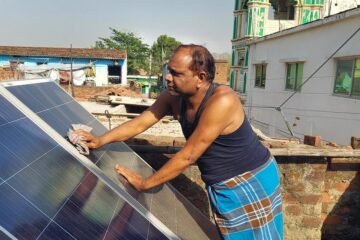
Understanding Ultraviolet (UV) Rays
Ultraviolet (UV) rays are a form of electromagnetic radiation emitted by the sun. These rays are classified into three main types based on their wavelengths: UVA, UVB, and UVC. Each type of UV ray varies in its energy level and potential impact on human health.
UVA rays have the longest wavelengths, ranging from 320 to 400 nanometers (nm), and consequently, they possess the least energy among the three types. Despite their lower energy, UVA rays penetrate the skin more deeply and are prevalent year-round. They are responsible for causing premature aging and can contribute to the development of some skin cancers.
UVB rays have medium-range wavelengths, falling between 290 and 320 nm. These rays carry more energy compared to UVA rays and are primarily responsible for sunburns. UVB rays are also significant contributors to the risk of skin cancer, including melanoma, the most dangerous form of skin cancer. Unlike UVA rays, UVB rays are partially absorbed by the Earth’s ozone layer, which reduces their reach but does not eliminate their harmful potential.
UVC rays have the shortest wavelengths, ranging from 100 to 290 nm, and therefore carry the highest energy levels. Fortunately, UVC rays are almost entirely absorbed by the Earth’s atmosphere, specifically the ozone layer, and do not reach the Earth’s surface. However, artificial sources of UVC, such as certain types of lamps and equipment, can pose dangers if proper precautions are not taken.
Understanding the different types of UV rays and their respective wavelengths and energy levels is crucial in recognizing the potential health risks associated with sun exposure. The sun’s emission of UV rays is a natural process, and while they play a role in vital processes such as vitamin D synthesis, excessive exposure can lead to significant health issues. Thus, it is imperative to take appropriate measures to protect oneself from the harmful effects of UV radiation.
Short-Term Effects of UV Exposure
The immediate impacts of ultraviolet (UV) exposure on the human body manifest prominently through sunburn, tanning, and other adverse reactions on the skin. When skin is exposed to UV rays without adequate protection, it can result in an inflammatory response known as sunburn. This condition is characterized by redness, pain, and in severe cases, blistering. The intensity of sunburn varies depending on the duration of exposure and the individual’s skin type.
Furthermore, UV exposure leads to tanning, which is the skin’s defense mechanism against further damage. Tanning occurs when UV rays stimulate the production of melanin, the pigment responsible for skin color, as a protective response. While a tan might be perceived as desirable by some, it is actually a sign that the skin cells have been damaged, prompting an increase in melanin to shield against deeper harm. This process, although protective in the short run, indicates cellular stress.
Beyond sunburn and tanning, acute UV exposure can cause other immediate biological responses. The skin may become dry, itchy, and exhibit signs of premature aging, such as wrinkles and fine lines. These effects are a consequence of the UV rays breaking down the collagen and elastin fibers in the skin. Additionally, some individuals may experience photokeratitis, a painful eye condition resembling a sunburn but affecting the corneas, resulting in temporary vision impairment and discomfort.
In summary, the short-term effects of UV exposure underscore the importance of preventive measures, such as wearing sunscreen, protective clothing, and sunglasses. Understanding these immediate impacts not only helps in mitigating acute discomfort but also in preventing more severe long-term damage. Awareness and proactive protection are key to maintaining healthy skin and overall well-being when exposed to the sun’s UV rays.
Long-Term Health Risks
Prolonged exposure to ultraviolet (UV) rays from the sun poses significant long-term health risks to humans. One of the most evident chronic effects is premature aging of the skin. Continuous UV exposure accelerates the breakdown of collagen and elastin fibers, leading to the early onset of wrinkles, fine lines, and age spots. The skin loses its elasticity and firmness, resulting in an aged appearance that can be difficult to reverse.
More alarmingly, UV radiation is a well-established cause of skin cancer. There are several types of skin cancer linked to UV exposure, including melanoma, basal cell carcinoma, and squamous cell carcinoma. Melanoma is particularly dangerous due to its tendency to spread to other parts of the body if not detected early. Basal cell carcinoma, while less likely to metastasize, can cause significant local damage and disfigurement. Squamous cell carcinoma also poses serious health risks, especially when it progresses untreated.
The eyes are not immune to the harmful effects of UV rays either. Chronic exposure can lead to cataracts, a condition characterized by the clouding of the eye’s lens, which impairs vision. UV radiation can also contribute to macular degeneration and pterygium, both of which can compromise visual acuity and quality of life.
It’s crucial to understand that UV damage is cumulative. The harmful effects build up over time, often going unnoticed until significant damage has occurred. This cumulative nature means that even intermittent exposure can add up, underscoring the importance of consistent sun protection measures. Regular use of sunscreen, protective clothing, and UV-blocking eyewear can mitigate these long-term risks and help maintain both skin and eye health.
Impact on the Immune System
Ultraviolet (UV) rays from the sun have a significant impact on the human immune system, which can lead to a higher susceptibility to infections and diseases. When UV radiation penetrates the skin, it can alter the function of immune cells, including Langerhans cells and T-lymphocytes, which are crucial for immune defense. These alterations can suppress the body’s immune responses, making it less efficient in combating various pathogens.
One of the primary mechanisms by which UV rays weaken the immune system is through the suppression of the skin’s antigen-presenting cells. These cells play a vital role in recognizing and presenting foreign substances to the immune system. When UV rays damage these cells, the immune system’s ability to detect and respond to infections is compromised. This suppression can lead to an increased risk of skin infections and may also have systemic effects, weakening the overall immune response.
Moreover, UV radiation induces the production of immunosuppressive cytokines, which further inhibit the activity of immune cells. These cytokines can reduce the proliferation of T-cells and their ability to respond to antigens. The diminished T-cell activity can lead to a less effective immune response, making the body more vulnerable to infections, such as viral and bacterial diseases.
The long-term health implications of UV-induced immunosuppression are significant. Chronic exposure to UV rays can lead to an increased risk of developing skin cancers, such as melanoma and non-melanoma skin cancers. Additionally, the weakened immune system may struggle to keep latent infections, such as herpes simplex virus, under control, leading to more frequent and severe outbreaks.
Understanding the detrimental effects of UV rays on the immune system underscores the importance of protective measures, such as using sunscreen, wearing protective clothing, and avoiding excessive sun exposure. By taking these precautions, individuals can help mitigate the harmful impacts of UV radiation on their immune health.
Environmental Factors Influencing UV Exposure
Various environmental factors play a significant role in determining the levels of ultraviolet (UV) radiation that humans are exposed to. One of the primary factors is altitude. At higher altitudes, the atmosphere is thinner, which means there is less atmospheric absorption of UV rays. Consequently, UV radiation increases by approximately 10% to 12% for every 1,000 meters of elevation, leading to higher exposure risks for people living or engaging in activities at high altitudes.
Latitude is another crucial determinant of UV exposure. Regions closer to the equator receive more direct sunlight throughout the year, resulting in higher UV radiation levels. Conversely, areas situated at higher latitudes, such as the poles, experience lower UV exposure due to the oblique angle at which sunlight strikes the Earth. This angle causes the sunlight to pass through a larger portion of the atmosphere, which scatters and absorbs more UV rays.
The time of day also significantly impacts UV radiation intensity. UV levels peak around midday, specifically between 10 a.m. and 4 p.m., when the sun is at its highest point in the sky. During these hours, the sun’s rays travel a shorter distance through the atmosphere, reducing scattering and absorption, and thereby increasing UV exposure.
Weather conditions can either amplify or mitigate UV exposure. Clear skies allow for maximum UV radiation to reach the Earth’s surface, whereas cloud cover can significantly reduce UV levels. However, it’s important to note that thin or scattered clouds might not provide sufficient protection and can sometimes even increase UV levels by reflecting and scattering sunlight.
Lastly, the depletion of the ozone layer has a profound effect on UV radiation exposure. The ozone layer acts as a protective shield, absorbing a substantial portion of the sun’s harmful UV rays. A thinner ozone layer means less absorption and, consequently, higher levels of UV radiation reaching the Earth’s surface. This increase in UV radiation poses greater health risks, emphasizing the importance of monitoring and addressing ozone layer depletion.
Protective Measures Against UV Rays
Exposure to ultraviolet (UV) rays can have detrimental effects on human health, necessitating the implementation of protective measures. The application of sunscreen is one of the most effective ways to safeguard against UV rays. It is recommended to use a broad-spectrum sunscreen with an SPF of at least 30, applying it generously on all exposed skin. Reapplication every two hours, or more frequently if swimming or sweating, is crucial to ensure continuous protection.
In addition to sunscreen, wearing protective clothing can significantly reduce UV exposure. Long-sleeved shirts, wide-brimmed hats, and long pants made from tightly woven fabric provide a physical barrier against UV rays. For added protection, clothing items with a high Ultraviolet Protection Factor (UPF) rating are advisable. Sunglasses that block 100% of UVA and UVB rays can protect the delicate skin around the eyes and reduce the risk of cataracts.
Seeking shade, especially during peak sun hours from 10 a.m. to 4 p.m., is another effective strategy to minimize UV radiation exposure. Utilizing umbrellas, trees, or shelters during outdoor activities can provide necessary respite from direct sunlight. It is important to remember that UV rays can penetrate clouds, making protection essential even on overcast days. Similarly, winter months do not eliminate the risk of UV exposure; snow can reflect UV rays, increasing the risk of sunburn.
Incorporating these protective measures into daily routines can mitigate the harmful effects of UV rays. Awareness and consistent practice of UV protection can significantly diminish the risk of skin cancer, premature aging, and other UV-related health issues. By combining sunscreen, protective clothing, sunglasses, and shade, individuals can enjoy outdoor activities while maintaining their health and safety.
Role of Public Awareness and Education
Public awareness and education play a pivotal role in mitigating the risks associated with UV exposure. Effective educational campaigns can significantly enhance public understanding of the dangers posed by prolonged exposure to the sun’s UV rays. These campaigns are instrumental in promoting sun safety practices and encouraging individuals to adopt protective measures.
Schools serve as a primary platform for instilling sun safety knowledge among young people. By integrating educational programs into the school curriculum, students can learn about the harmful effects of UV radiation from an early age. This foundational knowledge empowers them to make informed decisions about their sun exposure, such as wearing protective clothing, using sunscreen, and seeking shade during peak UV hours. Moreover, engaging educational activities and interactive sessions can make learning about sun safety both informative and enjoyable for students.
Healthcare providers also play a crucial role in educating the public about UV radiation hazards. During routine check-ups, medical professionals can offer personalized advice on sun protection and skin care. They can also identify individuals at higher risk of UV-related health issues, such as those with fair skin, a history of sunburns, or a family history of skin cancer. By providing targeted guidance and resources, healthcare providers help patients adopt effective sun safety habits tailored to their specific needs.
Governmental organizations are essential in orchestrating large-scale public awareness campaigns. Through public service announcements, social media outreach, and community events, these organizations can disseminate critical information about the risks of UV exposure and the importance of sun protection. Collaborations with schools, healthcare providers, and non-profit organizations further amplify these efforts, ensuring a broader reach and more comprehensive impact.
In conclusion, public awareness and education are vital components in the fight against the harmful effects of UV rays. By leveraging the resources and influence of schools, healthcare providers, and governmental organizations, we can foster a culture of sun safety and significantly reduce the incidence of UV-related health issues.
Future Research and Innovations
The continuous advancement in scientific research and technological innovations is essential in the battle against the detrimental effects of UV radiation. As understanding of UV exposure deepens, researchers are focusing on developing more effective ways to protect human health. A key area of progress is in sunscreen technology. Modern sunscreens are being formulated with enhanced broad-spectrum protection, capable of shielding the skin against both UVA and UVB rays. Researchers are exploring the incorporation of natural ingredients, such as antioxidants and plant extracts, which provide additional defense mechanisms against UV-induced damage.
In addition to improvements in sunscreens, there is a growing interest in protective clothing materials. Innovations in textile engineering have led to the creation of fabrics with high Ultraviolet Protection Factor (UPF) ratings. These materials are designed to block or absorb UV radiation, offering an added layer of defense for individuals spending extended periods in the sun. The integration of nanoparticles and advanced fabric treatments further enhances the protective qualities of these textiles, making them both practical and fashionable.
Ongoing studies are also examining the broader health impacts of UV exposure. Researchers are investigating the links between UV radiation and various skin conditions beyond cancer, such as photo-aging and immune system suppression. There is an increased focus on understanding genetic factors that influence individual susceptibility to UV damage. This research aims to develop personalized protective strategies and targeted therapies for those most at risk.
Through these efforts, the future holds promise for more effective methods to mitigate the harmful effects of UV rays. Continued innovation and research are vital in safeguarding public health, ensuring that individuals can enjoy the benefits of sunlight while minimizing associated risks. As we advance, the integration of scientific findings into everyday protective measures will be crucial in reducing the global burden of UV-induced health issues.


